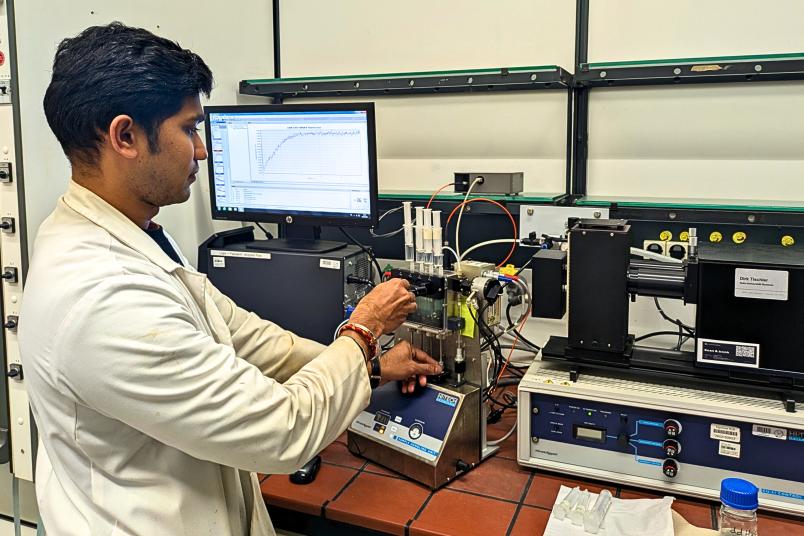
Selvapravin Kumaran, doctoral student in the Microbial Biotechnology working group, takes a measurement in the laboratory.
Biotechnology
Converting toxic styrene oxide into attractive compounds
Styrene oxide isomerase is proving to be a multifunctional helper for biotechnology.
The bacterial membrane enzyme styrene oxide isomerase can convert toxic compounds into valuable materials. Selvapravin Kumaran, a doctoral student in Professor Dirk Tischler's Microbial Biotechnology working group at Ruhr University Bochum, Germany, has discovered exactly how it does this. These findings could help in the future to use the multifunctional enzyme in other reactions involving the production of industrially attractive compounds from inexpensive precursors. “Enzymes are a powerful tool that can make our lives more environmentally friendly,” says Dirk Tischler. The researchers report their findings in the journal ACS Catalysis on September 29, 2025.
An enzyme with a previously unexplored mechanism
Bacterial styrene oxidase isomerase has been known to science for over three decades, but its mechanism of action has not yet been elucidated. “Working with this enzyme is difficult because it is anchored in the membrane of the bacterial cell system,” says Dirk Tischler. In collaboration with Delft University of Technology, his team was able to uncover the role of the amino acid tyrosine in the conversion of toxic styrene oxide through the rare Meinwald rearrangement.
Precisely tuned architecture of the enzyme
Previous work on the structure showed that the enzyme contains iron-containing heme, which drives the reaction. In the current study, the researchers report that the enzyme has a very strict architecture consisting of iron-containing heme and two amino acids—tyrosine and asparagine—that are precisely positioned to enable the reaction. By exchanging these amino acids and using modern biochemical methods, the team was able to show that the functional group of tyrosine plays a crucial role in the rearrangement of the substrate.
“This tiny enzyme uses the rare chemistry of the Meinwald rearrangement to selectively produce phenylacetaldehyde – controlled by the architecture of its active center,” explains Dirk Tischler. “Until now, the catalytic role of styrene oxide isomerase was only a hypothesis. Our work provides the first experimental evidence of how this enzyme works at the molecular level,” says Selvapravin Kumaran, first author of the paper.
Enzymatic versatility
Understanding the catalytic mechanism led the researchers to discover further potential applications for this enzyme. Styrene oxide isomerase can also be used for other purposes, similar to enzymes used in the textile industry to bleach dyes. For example, it can potentially detoxify hydrogen peroxide and also produce the valuable product phenylacetaldehyde directly from styrene – the precursor of styrene oxide in bacterial styrene degradation. Even though these additional activities are still relatively inefficient at present, the enzyme's multifunctionality could be exploited in the future to further develop it specifically for industrial applications and to produce high-quality products from inexpensive substrates such as styrene. “The potential of this enzyme goes far beyond the production of phenylacetaldehyde – it could drive a variety of different reactions. That's why we plan to continue exploring its possibilities,” says Dirk Tischler.